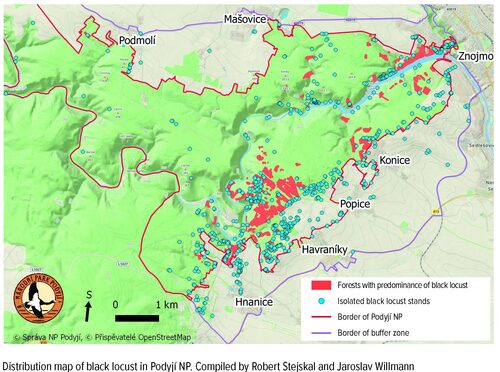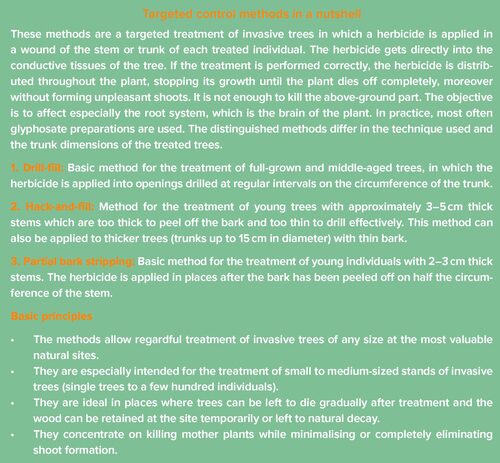Nature Conservation 2021 — 10. 6. 2021 — Nature and Landscape Management — Print article in pdf
Targeted Application Methods or a New/Old Tool for Controlling Invasive Alien Woody Plants:
the First Experience from the Podyjí/Thaya River Basin
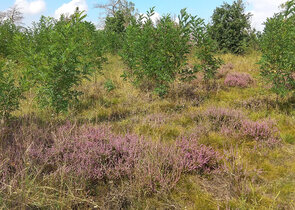
Invasive alien woody plants are a significant long-term problem of protected nature. Although we have been trying to control invasive alien woody plants, e.g. the most common Black locust (Robinia pseudoacacia), in many Specially Protected Areas in the Czech Republic, an effective management tool has been missing yet. In practice, there are various approaches differing in their philosophy and effectiveness and very often repeating mistakes, thus making sometimes the state of the art even worse instead effectively solving the problem. In this contribution, divided into several parts, the author would like to introduce the first experience from applying new measures in controlling the Black locust and other invasive trees and shrubs in the Podyjí/Thaya River Basin National Park (South Moravia).
The Podyjí/Thaya River Basin – a paradise of invasive woody plants
The Podyjí/Taya River Basin National Park (NP) is rich in invasive alien trees and shrubs. The most important is the Black locust, occurring on a total area of approx. 150 ha as continuous forests but also hundreds of isolated patches of various size and density in a broad range of habitats. It is an almost ubiquitous species in the NP´s eastern part. Old locust monocultures/plantations showing some stability as well as recent outbreaks with often stormy dynamics can be found in the area. The strongest threat to biodiversity is posed by black locust stands on steep slopes of the Dyje/Thaya River canyon, where it spreads into rock steppe and thermophilous oak forest habitats, not only vegetatively but thanks to the favourable conditions also by means of seed.
Insignificant in area, but more dangerous is the occurrence of the Tree of Heaven (Ailanthus altissima) and the Box elder (Acer negundo), which have recently spread precariously. Xerothermic habitats are locally threatened by the Lilac (Syringa vulgaris) and the Chinese wolfberry (Lycium barbarum), whereas humid forests are invaded by the overlooked Green ash (Fraxinus penssylvanica). The Oregon grape, also known as the Holly-leaved Berberry (Mahonia aquifolium) has so far gone unnoticed. It is locally invasive, similarly to Virginia creeper (Parthenocissus spp.). Less dangerous, though important in terms of size of the area of their occurrence, are the Norther red oak (Quercus rubra), Austrian or black pine (Pinus nigra) and te Douglas fir (Pseudotsuga menziesii). In the following text we will mainly focus on the issue of the Black locust.
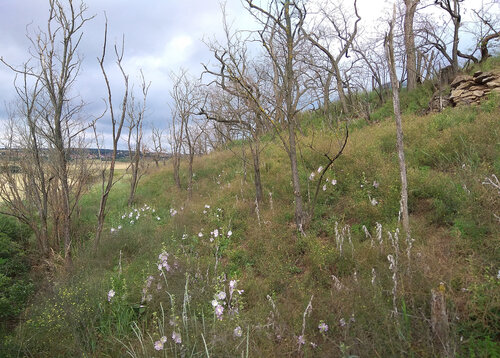
Dead black locusts (after injections) on loess among a rich population of
Alcea biennis in the undergrowth. © Robert Stejskal
How to defeat the Black locust
Efforts to control the Black locust began soon after the establishment of the NP in the early 1990s and have been a great conservation challenge to this day. Like anyone else who has dealt with the woody plant, also we had initially believed that black locust can be ‘overcome’ by ordinary felling. It soon became clear that the invasive alien speciesforming dense stands of unpleasant shoots, requires a special approach.
During the past 20 years, various mechanical, chemical, biological and combined methods have been used. The most frequent method was felling and smearing the saw cut in autumn, followed by yearly shoot elimination by applying a leaf herbicide for several years. Despite its high effectiveness, the method poses the risk of affecting the surrounding with the spray: it not only leads to a possible threat to valuable vegetation, but also to exposure of the soil surface, which increases the chance that invasive alien species or other undesirable vegetation re-establish there.
In order to minimalize or completely ban herbicides in a valuable area, particularly the high-stump method followed by breaking off shoots over 3–5 years has been recently practised. In addition to high labour and time demands, the method is limited by the fact that it can only be applied at sites with sufficient shade, thus it is not recommended in black locust monocultures/plantations or at non-forest sites. Besides, a relatively high survival rate of the root system has been observed and black locusts creep by means of root shoots to surrounding clearings and vegetation gaps. In rainy years, seemingly dead stumps rejuvenate.
On valley slopes and in the Dyje/Thaya River floodplain, technically and physically demanding girdling, otherwise practically ineffective in non-forest habitats, has locally proved to feasible.
In some places sheep and goat grazing has suppressed the black locust on heathland, but it has resisted grazing pressure in dense thickets and extensively grazed margins. Nevertheless, grazing can be recommended as an ideal management tool at sites where black locust has been removed successfully, since it reliably eliminates germinating - plants from the seed bank and sporadically appearing shoots. On a larger scale, grazing is unfortunately hindered by high technological and organisational demands.
Simply cutting shoots has shown to be completely inappropriate. Even after cutting for several years, the black locust not only remains, but rejuvenates even better when more is cut. Similarly, grubbing and digging up stumps or milling shoots were rejected. Just when the roots are disturbed, young shoots are formed in very high density.
In some stands we have relied on stand ‘aging’, i.e. leaving selected old black locust stands to natural decay. Unfortunately, when dead trees uproot, they start regenerating from the roots. Black locust thus does not even seem to recede in the competition of heliophobe sciophilous trees and shrubs, as is described by some authors (e.g. Vítková 2014), because even the smallest vegetation gap is enough for the successful rejuvenation.
Time for a change
Although the black locust has been successfully suppressed, comprehensive assessment has shown that removed stands not only regenerate, but also the number of new outbreaks rapidly increases. The exact data is not available, but the black locust is clearly spreading faster than we can control it applying the available management measures. Its spread is supported not only by human interventions but also by natural factors.
The Black locust spreads most often vegetatively when it is felled without using herbicides, either out of ignorance or in the naïve faith that shoots will later be eliminated by repeated cutting. A frequent problem is also insufficient management following up on deliberate felling. Black locust easily spreads when paths and tourist trails are maintained by shrub and tree cutting. A certain role maybe played by selective felling and tree theft.
The Black locust also finds good spreading conditions in oak forests where coppicing has been resumed. It occupies fresh clearings there, often together with the Tree of Heaven. Recently, it has been spreading considerably in pine stands which massively die as the result from long-term droughts. Uprooted pine trees damage admixed black locusts, which evokes a production of lots of shoots. The spread is also supported by roe deer shaking out their antlers. Black locusts girdled that way then rejuvenate vegetatively. In recent years, the spread of other invasive trees has also accelerated in a certain way, either as a result of climate change or by increasing populations of invasive alien trees, e.g. the Tree of Heaven, Box elder or Green ash, in the open landscape.
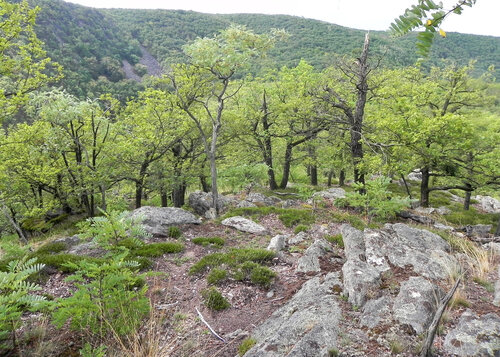
(Acidophilous) thermophilous oak forests in Podyjí on valley slopes are habitats
most endangered by black locust invasions. Besides former incidental exploitation,
erosion and activity of wild animals contribute to this. © Robert Stejskal
In an effort to change the negative trend, we have started to look for new ways to manage invasive alien woody plants. After a range of trials and errors made in efforts to eliminate them mechanically, we have come to the conclusion that effective black locust management requires the use of herbicides, which is a fact on which a broad group of professionals agree (e.g. Vítková & Sádlo 2018, Pergl et al. 2016, etc.). But can the herbicide also be used without the risk of damaging the natural environment?
We have found the answer in Hungary, where our colleagues have been dealing with the regulation of invasive woody plants for several decades. The results of their efforts can be seen not only in Hungarian national parks, but also in other protected areas. All methods used in Hungary are clearly summarised in the publication Practical Experiences in Invasive Alien Plant Control by Csiszár & Korda (2017). Exactly their elaborate measures, verified by extensive field experiments, have become the basis for our further activity.
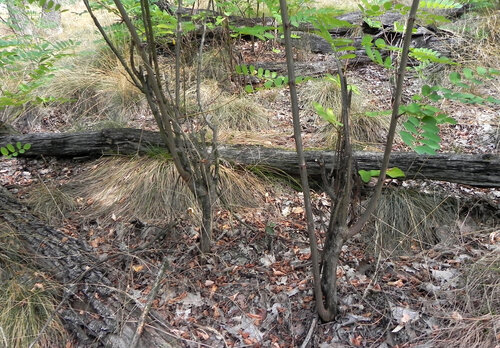
Young black locusts girdled by roe deer antlers successfully sprout, form
low-grade stems, and send root shoots out into the surrounding. © Robert Stejskal
What are targeted control methods?
After thorough checking and considering all details by conservationists, broad discussions with many foreign experts and professional internships just ‘at the scene’ in the Kiskunság NP, we concluded that the Hungarian methods of controlling invasive trees and shrubs are worth trying out, at least experimentally. Management successes achieved with applying these methods in other countries such as Slovakia, Italy, Cyprus and Israel were of great inspiration. The methods are also widespread in both parts of the American continent and in New Zealand.
The Hungarian methods are collectively referred to as targeted (direct) chemical control methods (TCCM). They basically are various modifications of herbicide injections directly into the invasive alien woody plant trunk, therefore combining a mechanical and a chemical treatment. Herbicide injections are not new to the Czech Republic. They have been known for decades and are included in the standard methodology Likvidace vybraných invazních druhů rostlin (Management of the Selected Alien Plant Species, Pergl et al. 2016). Here and there, injections were experimented with, but for unknown reasons the method has never been applied more and hardly any reports on practical experience in the Czech Republic have been published.
TCCM have been specially developed to control invasive alien plants at natural sites and in protected areas without negatively impacting sensitive habitats and non-targeted organisms, but their possible use is very universal in all types of the environment. TCCM eliminate the herbicide application on woody parts of a plant and exclude the spraying of its leaf surface because even very careful spraying affects the surroundings.
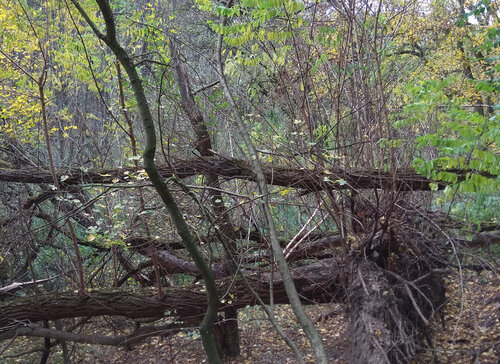
At several sites, overmature black locust stands disintegrate naturally.
The trees do not die off, unfortunately, but regenerate successfully after uprooting.
© Robert Stejskal
Why exactly targeted control methods
Regulation of the Black locust with common methods usually fails because we are not able to ensure regular suppression of shoots after the mother stand has been removed. After felling, the Black locust is able to rejuvenate at an exponential rate, particularly when no herbicide is used. We have always regarded the struggle with shoots a necessary evil. In practice it is strongly underestimated. Interventions (e.g. shoot cutting) usually have just a short-term effect and the original stand regenerates, only changing its form and age structure. The Hungarian experience therefore looked like incredible sci-fi to us, as black locust individuals really die off without later forming shoots (or with just minor rejuvenation) when correctly treated with TCCM.
Another typical aspect of TCCM is leaving treated trees to die gradually or to complete decay. Such an approach is completely opposite to conventional methods, which include wood removal. Practice has shown that especially the retention of young and middle-aged individuals is without any problems. Dry thin black locust shoots disintegrate rather quickly and practically ‘merge’ with the habitat. Medium-sized trunks can be left at the site or removed when the trunks accumulate in places where this is not desired. Full-grown trees may pose a risk to the surrounding as they may eventually fall down. It is recommended to leave black locust trees in forests in case they occur singly or in small groups/clusters. TCCM are particularly ideal in the above situations. For extensive black locust growths, it is usually the best to remove the dead stand and replace it with a more valuable community. We follow the simple rule that the greater the risk of dry trees for the surrounding is, the sooner they must be removed or arboristically adjusted to a safe torso. It is usually recommended to remove dead trees in the second season after treatment with TCCM. Close to paths and in other strongly exposed places, however, the trees must be removed earlier, but not before a clear effect of the applied herbicide appears, i.e. after complete defoliation of the treated trees, which occurs roughly a month after application. We must however count with the formation of shoots and the need to adapt the follow-up management to that. The issue of retaining dying trees is very specific, requiring a separate article, so beware of simplified conclusions.
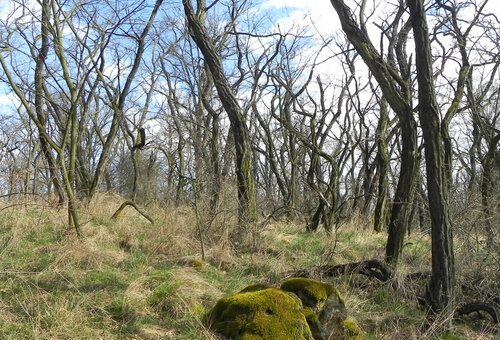
Podyjí NP has over 100 hectares of forest in which black locust predominates.
These stands are mostly found at sites of former pastures. © Robert Stejskal
At first sight, it looks like treating each invasive tree individually is extremely laborious and slow. It is true that, mainly when dealing with high tree densities, in low-grade multi-stem stands or there where black locust grows in dense rose and bramble thickets, it is a time-consuming and physically demanding activity. However, considering that most trees die after a single treatment, combined with minimal or no shoot formation, this ‘investment’ pays off richly. Moreover, when comparing with the commonly used approach of smearing stumps after cutting and the subsequent several-year long spraying of shoots, TCCM are actually very fast and simple.
In my opinion, the most essential for conservationists is that thanks to target control we can afford to treat black locust trees growing directly among rare and endangered plants. In Podyjí NP, black locust often grows in valuable heathland habitats, on rock steppes and in species-rich dry grasslands, as well as in forest clearings, directly between tufts of Pulsatilla grandis, in Dictamnus albus populations and at orchid sites. In these situations, it is hard to imagine that black locust would be removed in the traditional way, i.e. by smearing the stumps after felling and subsequent spraying, which would devastate the site.
In conclusion, TCCM can be regarded a very powerful (but not almighty) instrument in the invasive alien woody plant control, applicable in almost every situation, not only in natural habitats. The first experience with applying these methods in the Podyjí/Thaya River NP has provided promising results. We can only try to pass the experience gained on to others interested in this issue. Following contributions will explore how the treatment of trees by means of TCCM is carried out, which equipment is needed, and what should be respected and taken into account during the procedure.


